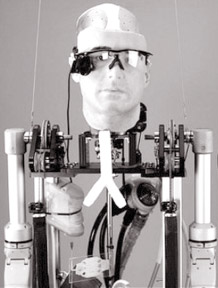'Bionic man' has artificial heart, prototype body parts
Frank's skeleton looks like it was made in a bike shop, his arms and
hands operate on batteries and a computer program lets him have an
"almost human-like conversation."
 Frank
is a bionic man, built for a Smithsonian Channel special about
state-of-the-art man-made body parts gathered from around the globe. Frank
is a bionic man, built for a Smithsonian Channel special about
state-of-the-art man-made body parts gathered from around the globe.
Bertolt Meyer, host of the documentary, was at the National Air and
Space Museum with Frank recently to tout the documentary that will air
on the Smithsonian Channel. Frank will remain on display at the museum
through December, when he will be dismantled and his parts returned to
the organisations that donated them for the project.
But the SynCardia temporary Total Artificial Heart that pumps plastic
blood through his plastic veins was made in Tucson, Arizona and it is
the only one of Frank's internal organs that is more than a prototype.
"All the other bits that we see here, like the artificial pancreas
here, the first prototype of an artificial kidney, spleen and lung -
they're all still prototypes and still have a very long way to go," said
Meyer. "Whereas the heart is already being used in patients."
Michael Garippa, Chief Executive Officer of Tucson-based SynCardia
Systems Inc., which manufactured Frank's heart, said the opportunity to
work with the Smithsonian was "too good to say no to."
"I think this was a real honour for us and a great chance for
technology that's largely been kept under a rock to get a lot of extra
attention," Garippa said. Meyer, a social psychologist at the University
of Zurich in Switzerland, said the documentary was "first and foremost
an educational project," meant to show viewers the latest developments
in the field. But it was also an education for him.
"I was absolutely stunned," he said of the progress in prosthetics
and artificial body parts. Meyer, who was born without the lower part of
his left arm and uses a prosthetic himself, said he hopes the program
will also spark a conversation about what continuing development in this
area could mean for society.
"What if an artificial heart can buy us more lifespan - what will a
society like that look like?" Meyer asked. "These (questions) kind of
alter the ethical implications of this technology."
In documentary
While some of the developments may seem like science fiction, much of
it is closer to science fact, said Dr. Daniel Tang, a surgeon at the
Virginia Commonwealth University Medical Center, who is featured in the
documentary.
"Have we gotten to the point where mechanical pumps can replace a
heart transplant?" Tang asked. "It's close."
The Total Artificial Heart is used to temporarily replace a human
heart for a patient awaiting a transplant, sometimes for years, Tang
said. Though it has been around largely in the same form since 1981, he
said, the man-made heart like that in Frank is a "miracle of medicine"
at a time when there are not enough human hearts available for
transplant.
"The amount of donor hearts that are available is far overshadowed by
the number of people on the waitlist," Tang said. "That kind of
discrepancy only continues to grow."
The SynCardia heart has been implanted in about 1,200 patients
worldwide since the 1980s, pumping real blood through real veins -
unlike the plastic blood it pumps for Frank. Garippa said it is the only
device approved in the US, Canada and the European Union for treatment
of heart failure involving both ventricles. In the past, patients with
the device had to stay in the hospital "tethered" to a 500-pound
console, Tang said, driving up costs and limiting how many people could
get the man-made heart. But a relatively new 13.5-pound portable device
makes it possible for patients to go home.
Garippa said the portable device has passed Food and Drug
Administration (FDA) trials and he hopes it will get full FDA approval
in November. If approved, the new device would reduce costs and
hardships associated with protracted hospital stays, he said. The
SynCardia heart is also becoming more widely available, with the number
of centres certified to implant it soon to increase from nearly 90 to
125 worldwide, a number that Garippa said will ultimately reach about
400.
Tang sees a day when artificial organs may be made of synthetic
tissue instead of metal and plastic. "It's an amazing time we're living
in," Tang said.
The body eclectic
"Frank" is not a complete person - he is missing key parts like a
brain, digestive system and skin - but he brings together in one "body"
more than a dozen man-made parts. In addition to the SynCardia temporary
Total Artificial Heart, Frank's parts list includes:
* Skull implants printed with a 3D printer
* The Argus II system that turns video into electrical impulses the
brain can "see"
* NeoSpeech software and a chatbot computer program that turns text
into speech and lets Frank have "almost human-like conversation"
* A cochlear implant that turns sound into electrical impulses
* A 3D-printed synthetic windpipe that can use a patient's stem cells
to prevent rejection
* An artificial lung that filters air and oxygenate blood
* An artificial pancreas that helps regulate blood-sugar in diabetics
without insulin injections
* A blood substitute made of plastic molecules with an iron atom at
their core that carries oxygen, but does not fully replace human blood
* A man-made spleen, still under development, that filters toxins
from the bloodstream
* Battery-powered prosthetic arms
* Touch Bionic i-Limb prosthetic hands
* Prosthetic hips that rotate up to 130 degrees
* Knees that adjust to different environments with the help of
gyroscopes, accelerometers and microprocessors
* BiOM ankles invented by a rock-climbing biophysicist and engineer
* The Rex exoskeleton that helps Frank "walk" and may one day replace
wheelchairs
- Cronkite News Service
|

